Field of Fireflies
First Generation
I'd first created fireflies for my White River & Northern II back in the late 1980s. It went like this: I inserted a few hundred fiber optic strands I'd painted green into a field made from thin foam rubber; the fibers stuck out of the ground like weeds. Then I filled in around them with ground foam vegetation. The other ends of the fibers were connected to a mechanism that slowly moved yellow-green lights past the fibers (I had to tint clear bulbs myself with transparent paints to achieve the right color). The result exceeded my expectations, and I've wanted to reproduce the effect ever since. Below is a view of the field after installing the fibers but before adding the vegetation, back in 1987.
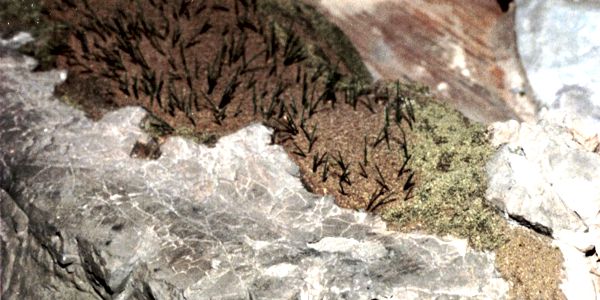
I used the same device to make a campfire effect as well. The device had two rotating drums (copper-colored discs, below): one for the campfire, on the left, and one for the fireflies, on the right. The mechanism was designed so that the campfire drum rotated twice as fast as the firefly drum. Each drum had a series of colored GOW bulbs (LEDs were not yet cheap and plentiful) that passed the ends of the fibers as the drums rotated. Additionally, there were multiple layers of bulbs, which could be turned on in sequence to simulate increasing numbers of fireflies.
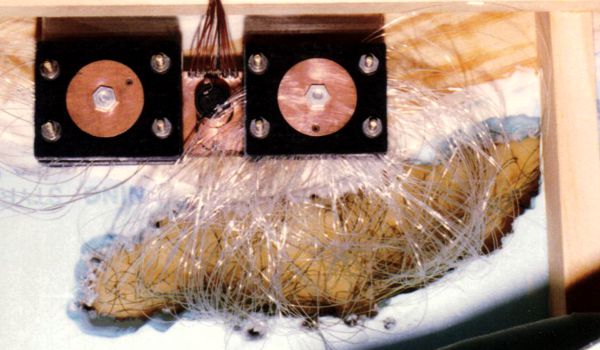
Second Generation
The thing I didn't realize about this crazy old contraption when I built it is just how strikingly realistic the effect would be. But I wanted to replicate it using LEDs and electronics. Several Christmases ago, after the season ended, I found a slew of "falling star" icicle lights on sale for dirt cheap, so I bought out two stores' worth and dismantled them (below left); I'd intended to use them for a fireworks display I'd never built. Around the same time, I'd stockpiled hundreds of yellow-green 3mm LEDs (below right) I'd intended to use for a 1:1 rock garden display I'd never built. Fast-forward to 24 April 2020, and I'm seeing all of this as the perfect way to make a "solid state" firefly effect, since the falling star LEDs blink on and then fade out gently, with a nice delay before the sequence repeats.
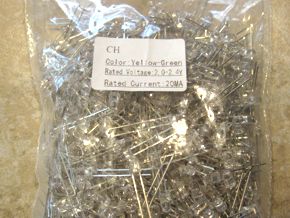


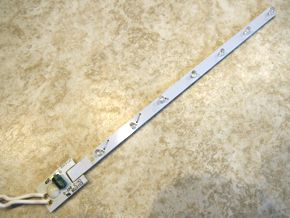
Each unit (above left) is relatively easy to dismantle and break down to its core component: a PC board with all of the electronics. As a proof-of-concept, I connected seven yellow-green LEDs to a board, and they started winking away just as I'd hoped.


The next step was to assemble twenty illumination modules (I had enough materials to build many more, but I figured this was enough for my little layout.) This involved bending the leads of 140 LEDs to various shapes, soldering them to the modules, and testing them (above left). Then I built a styrene rack to hold the modules (above right), drilled a #76 hole in the end of every LED, and installed the fibers. Finally came the moment-of-truth test (below), and I got lucky: the new effect was every bit as good as the original. This aspect of the project was completed on 28 April 2020.

This time I took a slightly different approach to installation: I fabricated a completely self-contained chunk of scenery, since installing the fibers in situ on the layout would have been a virtual impossibility. on 1 September 2020 I made a box from Gatorfoam having only a bottom, front and sides (below left). I topped it with a sheet of Martin Welberg Type C wild shrubbery (below right); however, the sheet was not opaque, and the LED modules would be directly beneath it, so I spray-glued it to a piece of aluminum foil, then pinned it to the edges of the box (bottom right).




After spraying the fibers flat green (above left), I painstakingly inserted all 140 of them through holes I poked in the shrubbery sheet with a pin (below left); this was the most nerve-wracking step, because the fibers would snap with the greatest of ease. In fact, I know I broke one fiber during the installation, so there are 139 fireflies instead of 140. Finally, I glued the LED rack into the back of the box, and clipped the fibers off flush with the shrubbery (below right).


Time to fire up the fireflies!

And here's a peek "under the hood" while it's running.

The project was completed on the morning of 2 September 2020.
|
|
New Digs
After the Mountain Vista was decommissioned, the fireflies quickly found a new home on the White River & Northern X. Indeed, I wasn't going to build this layout if I couldn't include it; the field occupies the space shaded green below. Activating the fireflies or the campfire starts the cricket sound effect.
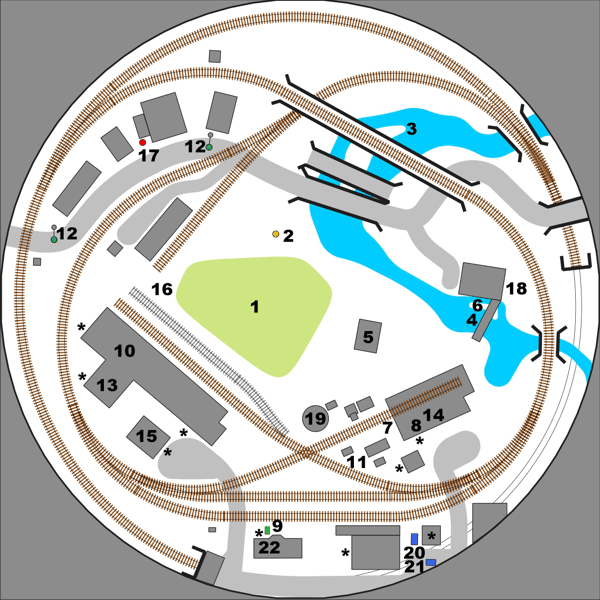
Work on reinstallation began on 11 May 2021-2022 by partially dismantling it—the box on which the field was mounted was made to fit the Mountain Vista, so that had to go. In the process, several fibers were damaged, so I made repairs. Then I fabricated a new box in situ and installed the field; this was completed on 17 May 2021.

Here it is with the adjacent campground:

The White River & Northern X has since been decommissioned, and the field of fireflies has become the main event on the Field of Dreams diorama.
Aesthetic Improvement
The electronic firefly effect was as good as I'd hoped—which is to say it was better than expected. Except... when you first turn it on, all of the flasher units fire off at once. While it's true there are some species of firefly that blink in sync, they're not common around these parts, so it looks unnatural. Although the synchronized blinking only lasts about a minute before the 20 chips start to get more random, being incredibly fussy about such things, I had to fix it. All together now: "But how?"

Decommissioning the White River & Northern X provided some unexpected bonuses, one of them being the availability of a player piano device that was no longer needed for randomized building lights. With 15 channels, it had just the right amount of control for the fireflies, which had 20 chips. I simply doubled up a few chips, and wired them all right into the player piano as-is, with no modification.
The results exceeded expectations because, in addition to eliminating the synchronized winking, the device also energizes the chips one or two at a time, so the winking starts out subtle and gradually increases, just as it happens in life:
|
|
By the way, this video looks better if you watch it on YouTube using dark theme.
Fireflies "Lite"
I wanted to add fireflies to another much smaller area, so I devised a method of optically coupling 5-6 fibers to the ends of yellow-green LEDs that replaced the existing LEDs. I left the long PC board assemblies in place, which saved a considerable amount of construction time, and also spread the fibers out. I installed two units in the Saturday at the Park diorama.

Above is the assembled light unit; below is a pair of units installed on the Saturday at the Park diorama.

Reference
During the film photography era, I spent years photographing fireflies; I'd make exposures of up to an hour or more and capture millions of winks on each frame. It was always fascinating to study the images and see the different flash patterns and color tints of various species of firefly.

This brief video is not all that great, but it does provide a reference for their behavior.
|
|
The saddest thing is that fireflies face extinction. Between habitat loss, light pollution, pesticides, global warming and a host of other manmade evils, we're killing them off. This time around, I've created my firefly effect as a paean to what we're destroying. A fellow modeler described my effort as a "Zen masterpiece."
